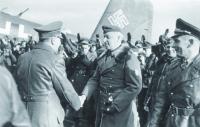
Adolf Hitler(l), Field Marshal Erich von Manstein(c, shaking hands with Hitler) and Field Marshal Dr. Baron Wolfram von Richhofen(r) at Zaporozhye.
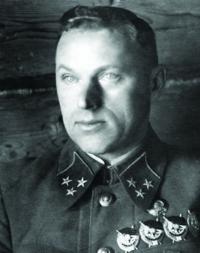
Konstantin K. Rokossovsky, commander Central Front, became Marshal of the Soviet Union and Marshal of Poland.
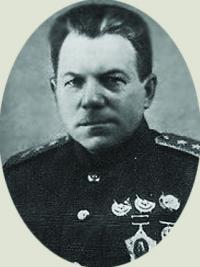
Max Andreyevich Reyter, commander Bryansk Front.
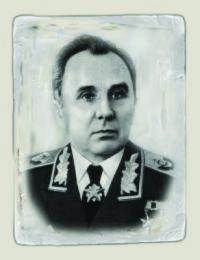
Two-time Hero of the Soviet Union, Kirill Semenovich Moskalenko, commander of 40th Army, became a Marshal after the war.
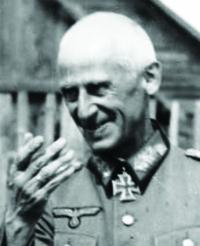
Hermann Hoth, commander Fourth Panzerarmee wearing Knight's Cross.
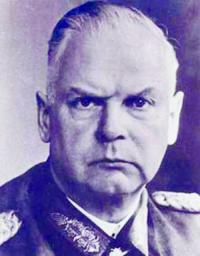
Eberhard von Mackensen, commander First Panzerarmee.
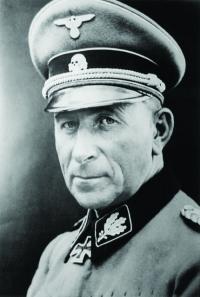
Paul Hausser, commander SS Panzerkorps, wearing Knight's Cross.
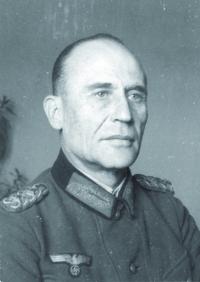
Friedrich Kirchner, commander LVII Panzerkorps.
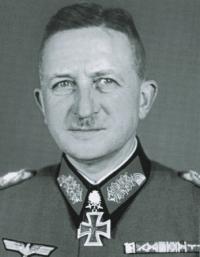
Otto von Knobelsdorff, commander XLVIII Panzerkorps.
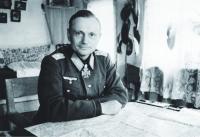
Hermann Balck, cmdr. 11th Panzerdivisione 'til March 4, 1943; then cmdr. XXXX Panzerkorps, wearing Knight's Cross with Oak Leaves.
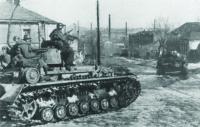
SS Das Reich Panzers enter Kharkov.
This month, 70 years ago, German Field Marshal Erich von Manstein launched a counteroffensive against the Red Army, which had just recaptured the Ukranian city of Kharkov. Currently, with a population of around one and a half million, Kharkov is the second largest city in the Ukraine, with a significant amount of industry. At the beginning of the war it was the largest city in the Ukraine. Its Freedom Square is the largest in the country. It is home to the largest Buddhist Temple in Europe, built by the Vietnamese population of Kharkov.
The Red Army had driven the Wehrmacht out of Kharkov on February 15, 1943, despite der FührerÙs orders to hold it. Der Führer flew to Field Marshal von MansteinÙs headquarters at Zaporozhye to "sort things out." Zaporozhye is located on the Dniepr River, and today has a population of 775, 000 and is the sixth largest city in the Ukraine. In 1943, its population was 120,000 - less than half the prewar number. While Hitler was there, Soviet armor attacked and came within 19 miles of the airfield. Before making his escape, Hitler gave the Field Marshal operational freedom
On February 19, Field Marshal von Manstein sent Herman HothÙs Fourth Panzerarmee and Eberhard von MackensenÙs First Panzerarmee against an overstretched and exhausted Red Army. On paper it looked as if there was no chance of a German success. The under strength forces that Field Marshal von Manstein threw against the Red Army numbered 70,000, while the Red Army counted 210,000. The difference was in leadership.
General HothÙs Fourth Panzerarmee contained the XLVIII Panzerkorps and the SS Panzerkorps, commanded by Otto von Knobelsdorff and Paul Hausser. The XLVIII Panzerkorps contained the 6th, 11th and 17th Panzerdivisiones commanded by Generals Walter von Hünersdorff, Hermann Balck (until March 4, 1943, when he was given command of XXXX Panzerkorps and succeeded by Dietrich von Choltitz) and Fridolin von Senger und Etterlin. The SS Panzerkorps was the elite of the elite, containing the 1st Liebstandard Adolph Hitler, the 2nd Das Reich and the 3rd Totenkopf SS Divisions, under the command of Joseph "Sepp" Deitrich, Herbert-Ernst Vahl and Theodore Eicke, who was followed after his death, on February 26, by Hermann Priess.
General von MackensenÙs First Panzerarmee contained the XXXX and LVII Panzerkorps, commanded by Hermann Balck (from March 4, 1943) and Friedrich Kirchner.
Also present was the LuftwaffeÙs Luftflotte IV which would be instrumental in the coming victory, by achieving air superiority, for the last time, over a battlefield on the Eastern Front. Luftflotte IV was commanded by GermanyÙs newest Field Marshal - Baron Dr. Wolfram von Richthofen - cousin to the famed Red Baron.
Opposing the Germans were the Red ArmyÙs Bryansk, Voronesh and Southwestern Fronts (army groups), commanded by Max Andreyevich Reyter from Latvia, Filipp Ivanovich Golikov and Nikolai Vatutin. With the elimination of the Stalingrad pocket, Konstantin K. RokossovskyÙs Central Front was transferred to this sector as well. By February 23, the Wehrmacht had bagged 9000 Soviet prisoners near the Samara River. Das Reich captured the hamlet of Lozovzya on February 26. Two days later, 17th Panzerdivision took the village of Petrovskoye. On March 6, General HothÙs Fourth Panzerarmee was within 10 miles of Kharkov. By then the Red Army had suffered 23,000 killed and lost 615 tanks and 352 artillery pieces. The western outskirts of the city were reached by the SS Panzerkorps on March 9.
The next day, HausserÙs SS Panzerkorps, led by "Sepp" DeitrichÙs 1st SS Division Liebstandard Adolph Hitler, in defiance of Field Marshal von MansteinÙs explicit order, began an assault on the city. It was the SS Panzerkorps that had abandoned the city - to avoid its own destruction - the previous month, in spite of HitlerÙs order to hold. Dzerzhinsky Square, named for the first, post-Civil War, Soviet Minister of the Interior, "Iron Felix" Dzerzhinsky, was immediately renamed "Platz der Liebstandard Adolf Hitler." At the time, it was the biggest square in all of Europe.
By March 14, 2/3 of the city was under the control of the SS. The SS was finally able to declare the city secured on March 16. After securing the city, and discovering that their comradesÙ graves had been desecrated and their bodies mutilated, the SS murdered 200 wounded Soviet soldiers convalescing in a hospital and burned it.
By not following Field Marshal von MansteinÙs orders, and surrounding the city, instead of fighting for it block by block and house by house, the SS lost 44% of its strength. The SS Panzerkorps suffered 11,500 casualties during the campaign, of which 4500 were from the 1st Liebstandard Adolph Hitler. Der Führer said that the SS Panzerkorps was, "...worth 20 Italian divisions." Given the disparity in equipment quality, that was probably an accurate assessment.
On March 16, the LAHÙs "Blowtorch Battalion," led by Joachim Peiper, and supported by waves of Stuka dive-bombers, and including some of the new Tiger tanks, made a dash for Belgorod, which was defended by the Soviet 69th Army, commanded by Vasilii Dmitrievich Kriuchenkin. The 40th Army, commanded by Kirill Semenovich Moskalenko, had recaptured the city on February 9. Today, it is a city of 350,000. PeiperÙs force arrived at the city center at 11:35 A.M., March 18, 1943. With the arrival of Das ReichÙs Deutschland Panzergrenadier Regiment, the city was secured for the Germans.
In addition to losing these two cities, the Red Army suffered 80,000 casualties, over half of which were deaths. It also lost 1140 tanks and 3000 guns. The German Führer declared the battle, "...a turning point in the fortunes of battle." Although it wasnÙt that, it was the last significant victory of the Wehrmacht. And it was the last time the Luftwaffe achieved clear air superiority over the enemy.
The Red Army liberated Kharkov, for the last time, on August 23, 1943.
NEXT: CHINDITS IN BURMA
Mr. Wimbrow writes from Ocean City, Maryland, where he practices law representing those persons accused of criminal and traffic offenses, and those persons who have suffered a personal injury through no fault of their own. Mr. Wimbrow can be contacted at wimbrowlaw@gmail.com
«Go back to the previous page.










